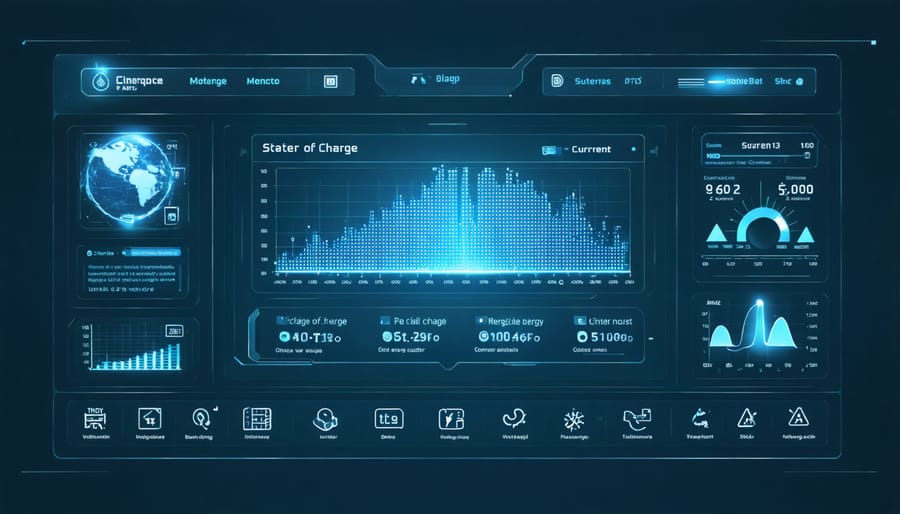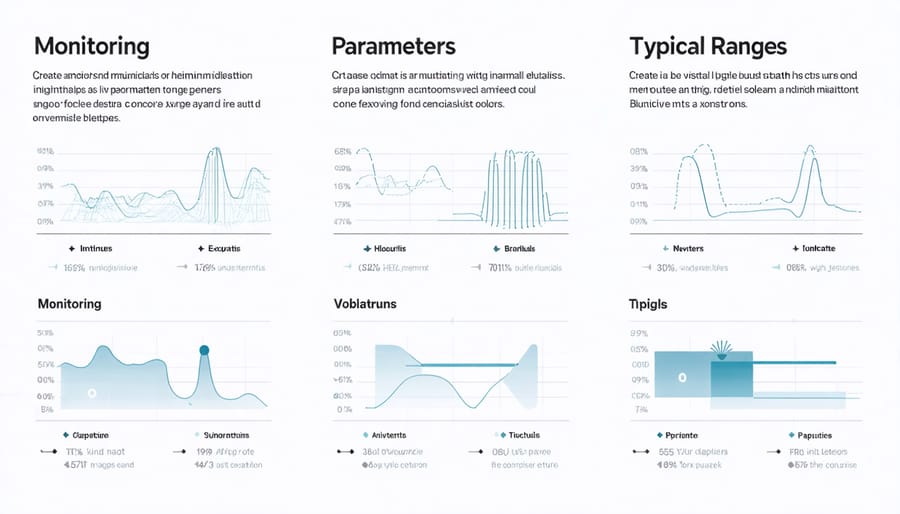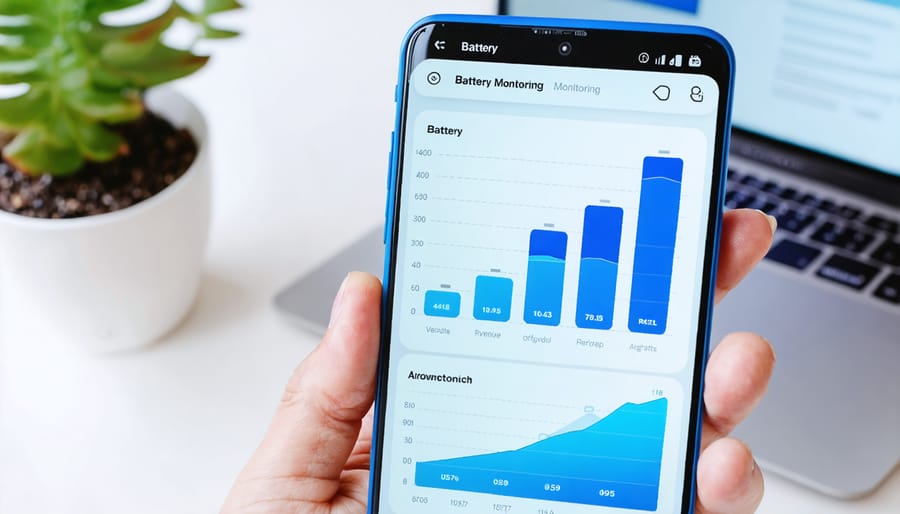Solar Battery Monitors: Your Power System’s Silent Guardian

A solar system battery monitor serves as your power system’s intelligent guardian, providing real-time insights into your energy storage performance through seamless battery monitoring. This sophisticated device tracks crucial parameters including state of charge, voltage levels, current flow, and temperature—essential metrics that determine your system’s efficiency and longevity. For European households and businesses investing in solar energy, these monitors have become indispensable tools for optimizing energy consumption and preventing costly battery failures.
Modern battery monitors integrate advanced digital displays and smart connectivity features, enabling remote system management through mobile applications and web interfaces. This technology revolution transforms how we interact with solar power systems, offering unprecedented control over energy storage and consumption patterns. By providing early warning signs of potential issues and detailed performance analytics, these monitoring systems ensure optimal battery health while maximizing the return on your renewable energy investment.
What is a Solar Battery Monitor?

Key Components
A solar battery monitoring system consists of several essential components working together to provide comprehensive oversight of your energy storage system. The primary component is the monitoring unit itself, which serves as the system’s brain, processing and analyzing data from various sensors. These sensors, strategically placed throughout the battery system, measure crucial parameters such as voltage, current, temperature, and state of charge.
The system includes a shunt resistor or current transformer that precisely measures the flow of electricity in and out of the batteries. This component is vital for calculating energy consumption patterns and charging efficiency. A display interface, either built into the unit or accessed through a mobile app, presents this information in an easy-to-understand format.
Communication modules enable data transmission, often utilizing Wi-Fi, Bluetooth, or cellular connectivity to send information to cloud-based platforms. This allows for remote monitoring and historical data analysis. Many modern systems also incorporate smart sensors that detect potential issues like sulfation or irregular charging patterns.
The voltage sensors continuously monitor individual battery cells or battery banks, ensuring balanced charging and optimal performance. Temperature probes protect your investment by alerting you to any concerning thermal conditions. Most systems also include sophisticated software that processes this data to provide predictive maintenance alerts and system optimization recommendations, helping extend battery life and maintain peak efficiency.
How Battery Monitors Work
Battery monitors employ sophisticated sensing technology to track and measure various parameters of your solar storage system in real-time. These devices connect directly to your battery bank through precision voltage sensors and current shunts, enabling accurate measurements of crucial data points.
The monitoring process begins with voltage sensing, where the device continuously measures the battery’s voltage levels. Simultaneously, current shunts installed in series with the battery measure the flow of electricity both in and out of the system. These measurements are processed by the monitor’s microcontroller, which uses advanced algorithms to calculate important metrics such as state of charge, power consumption, and charging efficiency.
Modern battery monitors also incorporate temperature sensors to track battery temperature, which is essential for optimal performance and longevity. The collected data is typically stored in the device’s memory and can be accessed through a digital display or transmitted wirelessly to connected devices.
Many contemporary monitors feature built-in communication modules that enable remote monitoring capabilities. These modules can transmit data via Bluetooth, Wi-Fi, or cellular networks to cloud-based platforms, allowing users to access their battery information through smartphone apps or web interfaces.
The monitoring system regularly updates these measurements, usually several times per second, ensuring that users always have access to current and accurate information about their battery’s performance and health status.

Essential Monitoring Parameters
State of Charge (SOC)
State of Charge (SOC) is a crucial metric that indicates your battery’s current charge level as a percentage of its full capacity. Modern battery management systems use sophisticated algorithms to calculate this value precisely, helping you maintain optimal battery health. Understanding SOC is essential for efficient energy management, as it helps prevent both over-discharge and overcharging situations.
A healthy operating range typically falls between 20% and 80% SOC, though specific ranges may vary depending on battery chemistry and manufacturer recommendations. When your battery’s SOC drops below 20%, most monitoring systems will trigger alerts to prevent deep discharge, which can significantly impact battery longevity. Similarly, maintaining awareness of upper charge limits helps protect your investment and ensures sustainable operation of your solar energy storage system.
Voltage and Current Readings
A solar battery monitor continuously tracks two fundamental electrical parameters: voltage and current. Voltage readings indicate your battery’s charge level and overall health, typically displaying values between 11V and 14.4V for 12V systems. Current measurements show the flow of electricity in and out of your battery, helping you understand charging and consumption patterns.
These readings are essential for maintaining optimal battery performance and longevity. By monitoring voltage levels, you can prevent harmful deep discharges and overcharging situations. Current readings help you identify unexpected power drains and verify that your solar panels are charging effectively.
Modern battery monitors display these values in real-time through digital interfaces, making it easy for system owners to make informed decisions about their energy usage and system maintenance needs.
Temperature Monitoring
Temperature monitoring is a crucial aspect of battery health management in solar systems. Batteries operate most efficiently within specific temperature ranges, typically between 20-25°C, and exposure to extreme temperatures can significantly impact their performance and lifespan. Modern battery monitors continuously track temperature variations, providing real-time alerts when readings fall outside optimal ranges.
During summer months, excessive heat can accelerate battery degradation and reduce charging efficiency. Conversely, cold temperatures can diminish battery capacity and slow down chemical reactions essential for proper functioning. Advanced monitoring systems help prevent these issues by enabling proactive temperature management through ventilation control or heating solutions when necessary.
For European installations, where seasonal temperature variations can be significant, this feature ensures year-round system reliability and maximises battery longevity through intelligent temperature oversight.
Benefits of Battery Monitoring
Extended Battery Life
A solar system battery monitor plays a crucial role in extending the lifespan of your energy storage solution. By providing real-time data on charging cycles, depth of discharge, and usage patterns, these monitoring systems help prevent common issues that can shorten battery life. The monitor alerts users when batteries approach critical levels, ensuring they don’t discharge too deeply, which can cause permanent damage.
Regular monitoring also helps maintain optimal charging conditions by tracking temperature and voltage levels. This precision management can significantly extend battery life, potentially adding years to your investment. For European installations, where energy efficiency standards are particularly stringent, these monitors ensure batteries operate within manufacturer-specified parameters.
The system’s predictive capabilities allow users to adjust their energy consumption patterns proactively, reducing stress on the batteries. By preventing overcharging and maintaining ideal operating conditions, a quality battery monitor helps maximise the return on your solar energy investment while supporting sustainable energy practices.
Optimal System Performance
A battery monitor plays a crucial role in maximising the efficiency of your solar power system by providing real-time data for optimal operation. When properly integrated, these monitoring systems help maintain ideal charging cycles and prevent both overcharging and deep discharging, significantly extending battery life. The system’s continuous oversight ensures that power generation and consumption remain balanced, reducing energy waste and improving overall system performance.
By tracking key parameters like state of charge and discharge rates, battery monitors enable automated system adjustments that can increase energy yield by up to 20%. This intelligent monitoring also helps identify potential issues before they impact system performance, reducing downtime and maintenance costs. For European installations, where seasonal variations can significantly affect solar production, these monitors provide essential data for optimising energy storage and usage patterns throughout the year.
The result is a more sustainable and cost-effective solar installation that delivers consistent power while maintaining battery health and system longevity.
Integration with Smart Systems
Modern solar battery monitors seamlessly integrate with smart home ecosystems, offering unprecedented control and visibility over your energy management system. These sophisticated devices connect to your home’s Wi-Fi network, enabling real-time monitoring and control through dedicated mobile apps or web interfaces.
When integrated with smart solar storage solutions, battery monitors can automatically adjust charging and discharging patterns based on your household’s energy consumption habits, weather forecasts, and electricity tariff rates. This intelligent automation helps maximize self-consumption of solar energy while minimizing grid dependency.
Many advanced monitoring systems feature API integration capabilities, allowing them to work with popular home automation platforms like Home Assistant, Apple HomeKit, or Google Home. This integration enables users to create sophisticated energy management scenarios, such as automatically running high-consumption appliances during peak solar production periods or reserving battery capacity based on weather predictions.
The data collected by these monitors can be accessed remotely, enabling system owners to track performance, receive alerts, and make informed decisions about their energy usage from anywhere. Some systems even offer predictive maintenance capabilities, using artificial intelligence to detect potential issues before they become problems, ensuring optimal system performance and longevity.
For businesses, these smart monitoring systems can be integrated with building management systems (BMS) to create comprehensive energy management strategies that align with operational needs and sustainability goals.

Solar battery monitoring systems play a pivotal role in the sustainable energy landscape, serving as the vigilant guardian of your energy storage investment. By providing real-time insights into battery health, performance, and energy flow, these monitoring systems empower users to make informed decisions about their energy consumption and storage strategies.
For European households and businesses committed to renewable energy adoption, battery monitors have become an indispensable tool in maximising system efficiency and longevity. They not only protect your investment by preventing potential battery damage but also contribute to the broader goals of energy independence and environmental sustainability.
The ability to track, analyse, and optimise energy usage patterns through battery monitoring systems represents a significant step forward in smart energy management. As Europe continues its transition towards cleaner energy solutions, these monitoring systems will become increasingly crucial in building a more resilient and sustainable energy infrastructure.
By embracing battery monitoring technology, users can ensure optimal performance of their solar energy systems while contributing to a greener future. This investment in monitoring capability pays dividends through enhanced system efficiency, extended battery life, and improved energy management practices.
Leave a Reply